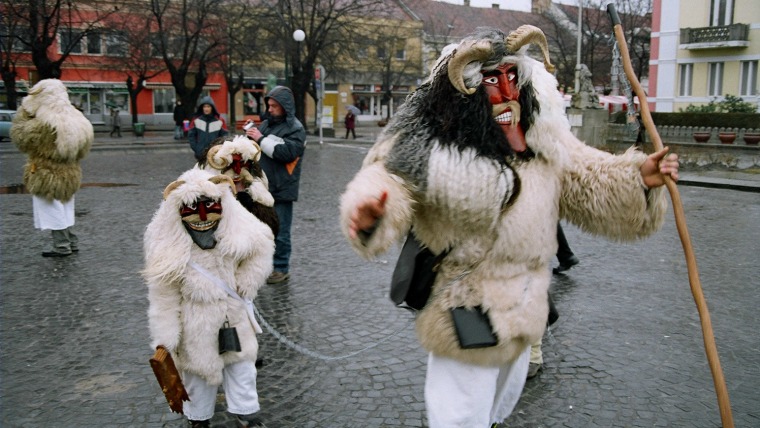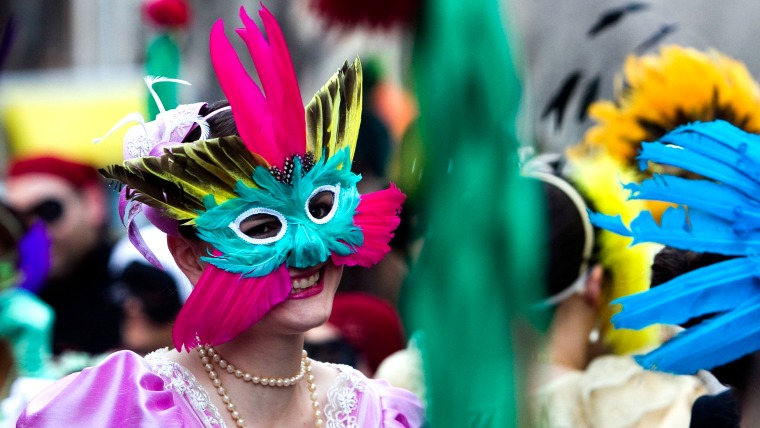How is Carnival celebrated in other parts of the world?
Carnival is linked to the Christian calendar and it was originally conceived as a period of revelry and frolics before Lent, a period of austerity and abstinence. The expansion of Christianity took the festival to many places in America, where it was mixed in with various local traditions. This has led to the Carnival taking on very different forms around the world. However, it still maintains a series of common features, such as the reversal of roles, popular triumph over established power, concealing one’s identity and committing excesses. Would you like to know more about the most outstanding European and American carnivals?
Ivrea, Italy. This Piemont town’s carnival has a Battle of the Oranges using real fruit, just like in 13th century Barcelona. The festival is a mixture of medieval features and references to the 19th century Napoleonic invasion. The central event recreates a popular rebellion against Napoleon’s lieutenant, but with a lot of Carnival influences: basically the people fight against an oppressive power to ensure their freedom. The festival has historical characters presiding over its events: Mugnaia, Sostituto Gran Cancelliere, Magnifico Podestá.
Venice, Italy. Venice holds one of the oldest and most famous Carnivals in the world; a public festival dating back to 1296. It was created by the Venice oligarchy as an amusement for the city’s population. The most important part of the festival are the costumes and masks, especially designed to hide the identity, gender and background of the people wearing them. Nowadays, it goes on for two weeks and combines public events and private parties. One of the best moments is the ‘Volo dell’Angelo’, an event that dates back to the 16th century. A tightrope walker crosses from the Basilica Sant Mark’s bell tower to the Ducal Palace, doing acrobatics on a high wire.
Cologne, Germany. The Carnival of Cologne is one of the most outstanding events in northern Europe, and every year it starts at 11:11 am on 11 November. However, the real festival begins on Carnival Thursday, a day when women take over the city, in a complete reversal of roles that is typically carnivalesque. The big day is the ‘rosenmontag’(Carnival Monday), when there are parades and people sing traditional songs in Kölsch, the old local language of Cologne. The Festkomitee Kölner Karneval has organised the festival since 1823. Every year, it chooses three representatives, who take on the interesting roles of the Virgin, the Prince and the Peasant.
Mohács, Hungary. This Hungarian town’s population, of Croatian origins, celebrate a Carnival that has been on the UNESCO Intangible Heritage of Humanity list since 2009. The most unusual feature of the festival are the “busós” costumes: groups of men dressed in animal skins with cowbells and wear demon-like, wooden horned masks. The origins of this carnival, which also has influences from Croatia, Serbia and Slovenia, are uncertain. But there is a local legend that says that during the Ottoman invasion, the local population had to hide in the forest and that they sometimes made incursions into villages dressed in that fashion in order to drive out the Turkish enemy.
New Orleans, United States. This is a city with a strong French flavour and this can be clearly seen in its carnival. The big day is Mardi Gras, the last day of Carnival, when more parades take place. The festival is organised around ‘krewes’ or social clubs, some of which are over a hundred years old, and that each one has its own programme. During the parades, thousands of plastic-bead necklaces are thrown from the floats. They have become a symbol of this carnival. Fritters, a foodstuff that is not easily found anywhere else in the United States, are typical of this festival with a strong French influence.
Oruro, Bolivia. Although it is not very famous, it is the second largest carnival in the world after Rio de Janeiro, in terms of the number of people it attracts. Millions of people in colourful fancy dress, pertaining to various social groups, crowd into the street and parade to the beat of typical dances, such as the Diablada, the Caporales, the Suri and the Waka waka. The Carnival ends with a grand parade lasting over fifteen hours, which ends early on Sunday morning. This festival, which is held to honour Our Lady of Foradada, is an interesting combination of Spanish and indigenous religious traditions. For all of these reasons, it was added to the UNESCO Intangible Heritage of Humanity list in 2003.
Barranquilla, Colombia. Its origins date back to the 19th century, and the week of celebrations attracts a million people. It is one of the most outstanding Carnivals in Latin America. The highlight of the carnival is on the Saturday, when the Battle of the Flowers, led by the Carnival Queen, opens the festivities. It has been on the the UNESCO Intangible Heritage of Humanity list since 2003, due to wealth of dances and traditional costumes, such as the Marimonda, the Garabato, the Congo and the Monocuco. Other outstanding features include ‘torito’ masks, satirical proclamations (litanies) and open-air celebrations.
Rio de Janeiro, Brasil. The Carnival of Rio de Janeiro is the best-known Brasilian carnival, which is celebrated in a similar fashion in other cities, such as Salvador de Bahia, Sao Paulo and Arrecife. It is a mixture of Portuguese, Spanish and Afro-Brasilian cultures. The festival is organised into ‘blocos’, groups of people who wear costumes based on a certain theme or celebrate the festival in a certain way. This is the case with the samba schools, which organise the most spectacular processions every year in the Sambòdrom, a place specially created for carnival parades by the prestigious architect Oscar Niemayer.








